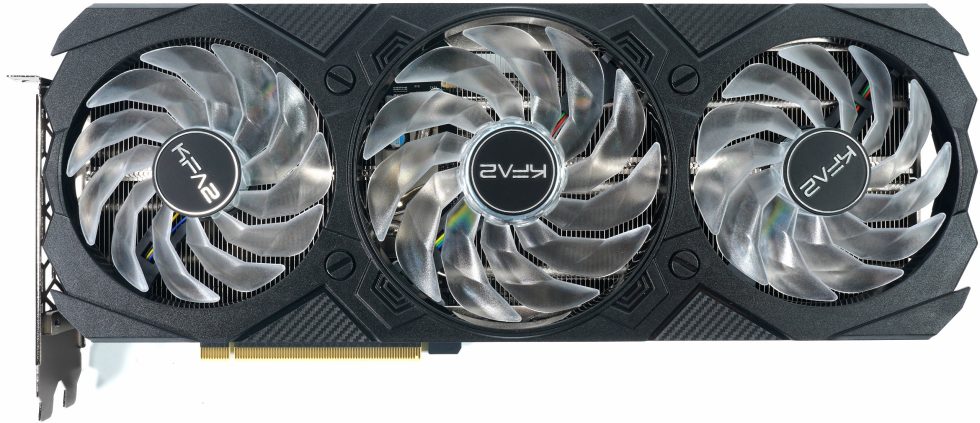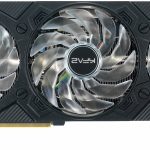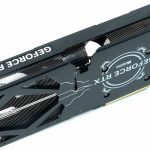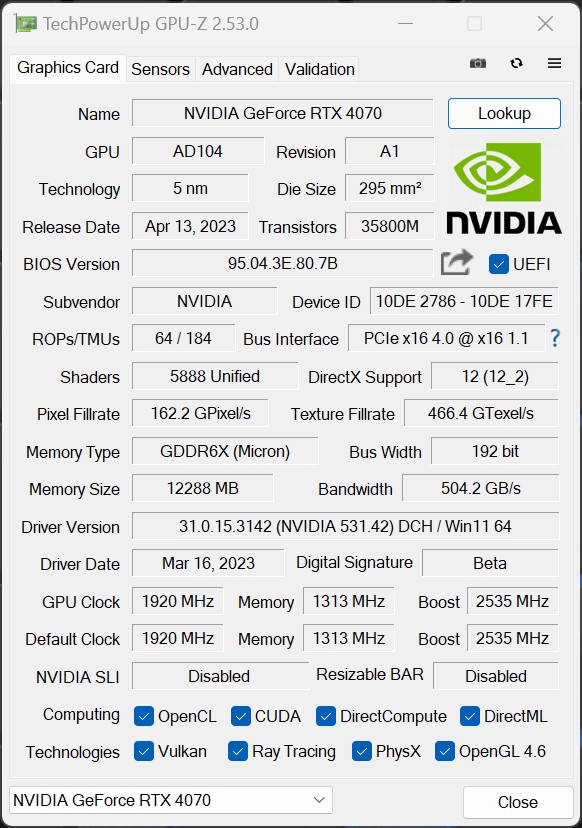Despite all the features like higher power limit, 3-fan design and ARGB, the KFA2 GeForce RTX 4070 EX Gamer (outside EU sold as Galax) belongs to the inexpensive models of the GeForce RTX 4070 series, which are now also sold well below the MSRP. So good, so exciting. Because the current street price is around 629 Euros and is really a real challenge to all the competitors. But how does that actually work when you look at the other competitor products in comparison and many features are simply missing at the same or even higher price? Ok, I kind of feel challenged to question this.
The card already uses a power limit of 215 watts from the factory, which is quite enough. Let’s remember my launch article, where even the NVIDIA RTX 4070 FE never really got above 215 watts despite the 220 watt power limit. This makes the card tested today a true OC card with non-OC default clock and the easy chance for the one OC click in the in-house software (gladly also via app) that is so fondly advertised by marketing. I would still set it manually, because the 3 GHz mark is definitely in there, depending on the chip lottery. And you could have done it right from the factory and thus kept the product name a bit shorter.
Why the MSRP card has a power limit of 215 instead of 200 watts (officially even allowed) has a very piquant background, which I explained in an extra article (link below). Because nothing has been written or leaked about it yet. That comes then exclusively from me 🙂
Of course, there is, as usual, the comprehensive teardown, an extensive PCB and cooler analysis with some reverse engineering, as well as the analysis of the power consumption and the load peaks including a suitable power supply recommendation. After all, we want to know everything in detail. Since I know that many colleagues will also repeat all the technical details including theory, which have already been presented in various tidbits, I’ll spare myself that today on a large scale and only briefly refer to the already known data. All cards with a factory clock or OC are within a tolerance range of less than 1%. These are measurement errors that can be safely ignored. The rest is decided by the selected chip anyway.
The AD 104 and the new Ada architecture
The 294.5 mm² chip of the NVIDIA GeForce RTX 4070 is also manufactured in the TSMC 4N process and has 35.8 billion transistors. The AD104-250 still has four Graphic Processing Clusters (GPC) and 46 new Streaming Multiprocessors (SM) with 5888 CUDA cores, whose performance and energy efficiency has increased significantly compared to Ampere. Add to that 184 4th generation Tensor cores and Optical Flow, enabling transformative AI technologies including NVIDIA DLSS and the new frame rate multiplier NVIDIA DLSS 3.
The 46 3rd generation RT cores provide up to 2x ray tracing performance, Shader Execution Reordering (SER) also improves ray tracing operations by 2x. In addition, there are a total of 23 Texture Processing Clusters (TPC), 184 Texture Units (TU) and 64 ROPs. The L2 cache is a total of 36864 KB and the card, like the GeForce RTX 4070 Ti, uses the familiar 12 GB GDDR6X with 10500 MHz clock on a rather narrow 192-bit interface, which corresponds to a data rate of 21 Gbps and a bandwidth of 504 GB/s. The AD104-250 of the GeForce RTX 4070 only offers one NVDEC (decoder) instead of four and a single NVENC (encoder). The AV1 encoder is said to work up to 40% more efficiently than H.264.
KFA2 GeForce RTX 4070 EX Gamer (1-Click-OC) 12 GB in detail
The card weighs 1063 grams, which puts it in the same weight class as NVIDIA’s Founders Edition. The length of 32.5 cm is anything but short and the height of 12 cm is also a bit above normal. You’ll need a lot of space in the case, even if you don’t have to use a 12VHPWR adapter. The installation depth is 4.3 cm plus the 5 mm for the backplate on the back. Thus, it is a rather expansive 2.5 slot card.
The design language of the fan, cover and slot bezel follow the company’s language and don’t surprise. The feel and look are of course also somewhat due to the price, even though there is of course ARGB galore. Two 9 cm and one 10 cm fan have the full power, plus the GeForce light field on top. The RGB has not been spared.
The card still relies on a PCIe Gen. 4 interface and the nice 8-pin connector, which has been recessed really deep. The default TBP is 215 watts and can’t be raised any further (which is pointless anyway, because then the voltage limits anyway). That’s also the reason for using the 8-pin connector, although it gets a bit tight. But I’ll come to that later,
You can not only put power into the card, but also video connectors. There are four of them, to be exact, as there are: three DisplayPort 1.4a and one HDMI 2.1a. That’s a shame, especially with the DisplayPort, when it comes to the new specifications. A missed opportunity, unfortunately. And with HDMI, you have to trick with the compression from 4K onwards if you want it to go above 120 Hz. I’ll go into the four screws in the direction of the cooler later in the teardown, because they are incredibly important.
The screenshot from GPU-Z shows us the default settings of the RTX 4070, which are almost identical for all cards:
This is the first page and we are slowly preparing for the test. For the forgetful or newcomers, I have also linked the launch article again, which offers more details and my comments on the MSRP cards:
- 1 - Introduction, technical data and technology
- 2 - Test System and the igor'sLAB MIFCOM-PC
- 3 - Teardown: PCB and components, cooler
- 4 - Gaming performance
- 5 - Details: Power consumption and load balancing
- 6 - Transients and PSU recommendation
- 7 - Temperatures, clock rates and infrared analysis
- 8 - Fan curves, noise and audio samples
- 9 - Summary and conclusion























































96 Antworten
Kommentar
Lade neue Kommentare
Veteran
Urgestein
Mitglied
Urgestein
Veteran
1
Urgestein
Moderator
Mitglied
Mitglied
Mitglied
Mitglied
Mitglied
Mitglied
Mitglied
Alle Kommentare lesen unter igor´sLAB Community →